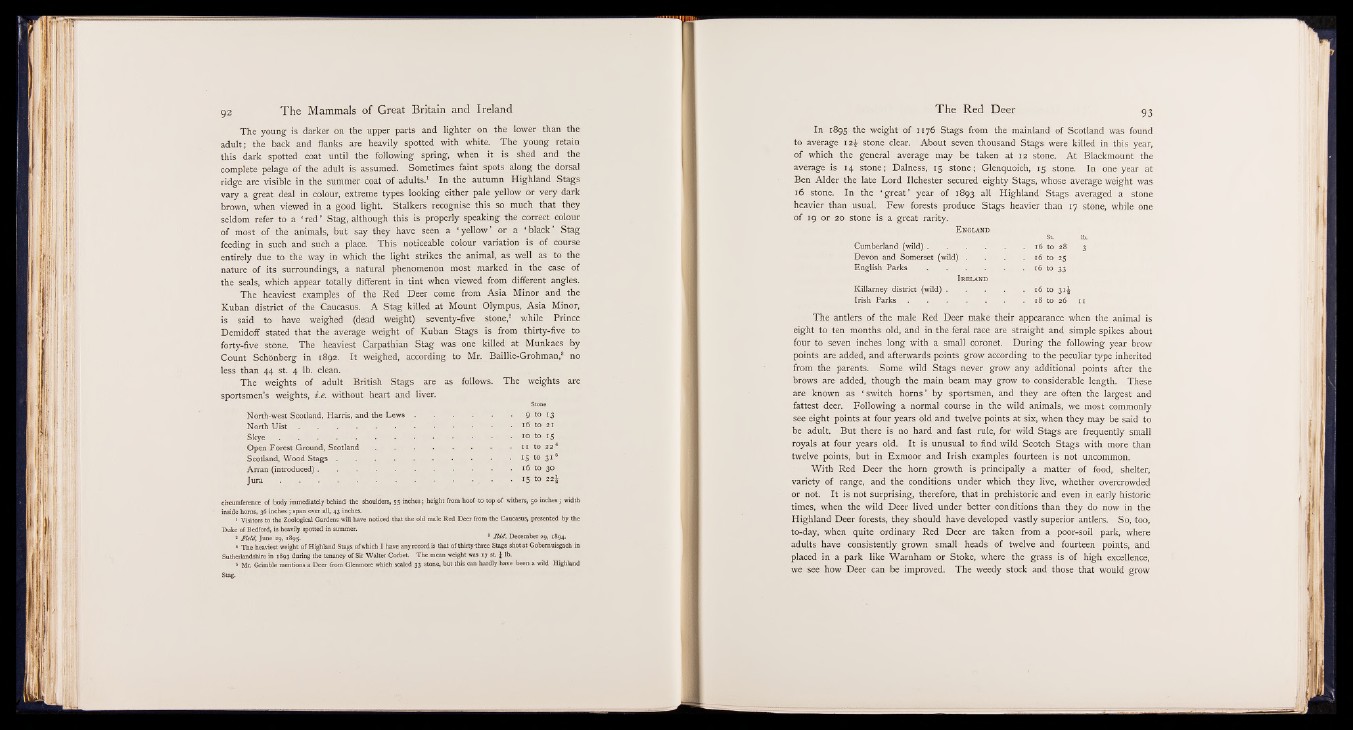
The young is darker on the upper parts and lighter on the lower than the
adult; the back and flanks are heavily spotted with white. The young retain
this dark spotted coat until the following spring, when it is shed and the
complete pelage of the adult is assumed. Sometimes faint spots along the dorsal
ridge are visible in the summer coat of adults.1 In the autumn Highland Stags
vary a great deal in colour, extreme types looking either pale yellow or very dark
brown, when viewed in a good light. Stalkers recognise this so much that they
seldom refer to a ‘ red' Stag, although this is properly speaking the correct colour
of most of the animals, but say they have seen a ‘ yellow’ or a ‘ black Stag
feeding in such and such a place. This noticeable colour variation is of course
entirely due to the way in which the light strikes the animal, as well as to the
nature of its surroundings, a natural phenomenon most marked in the case of
the seals, which appear totally different in tint when viewed from different angles.
The heaviest examples of the Red Deer come from Asia Minor and the
Kuban d is tr ic t^ the Caucasus. A Stag killed at Mount Olympus, Asia Minor,
is said to have weighed (dead weight) seventy-five stone,8 while Prince
Demidoff stated that the average weight of Kuban Stags, is from thirty-five to
forty-five Stone. The heaviest Carpathian Stag was one killed at Munkacs by
Count SchSnberg in 1892. It weighed, according to Mr. Baillie-Grohman,8 n®
less than 44 st. 4 lb. clean.
The weights of adult British Stags are as follows. The weights are
sportsmen’s weights, i.e. without heart and liver.
North-west Scotland, Harris, and the L e w s ..........................................................9 to 13
North U i s t ............................................................................................. 16 to 21
S k y e .............................................................................................................................. 10 to 15
Open Forest Ground, S c o t l a n d .............................. ■ . , ■ ?-
Scotland, Wood S t a g s ................................................................................................15 to 31 6
Arran (introduced).......................................................................................................... 16 to 30
J u r a ..............................................................................................................................'5 t0 22i
circumference of body immediately behind the shoulders, 55 inches; height from hoof to top of withers, 50 inches; width
inside horns, 36 inches ; span over all, 43 inches.
1 Visitors to the Zoological Gardens will have noticed that the old male Red Deer from the Caucasus, presented by the
Duke of Bedford, is heavily spotted in summer.
* Field, June 29,1895. 8 December 29, 1894.
* The heaviest weight o f Highland Stags of which I have any record is that of thirty-three Stags shot at Gobemuisgach in
Sutherlandshire in 1893 during the tenancy of Sir Walter Corbet The mean weight was 17 st. J lb.
6 Mr. Grimble mentions a Deer from Glenmore which scaled 33 stone, but this can hardly have been a wild Highland
Stag.
In 1895 the weight of 1176 Stags from the mainland of Scotland was found
to average 12% stone clear. About seven thousand Stags were killed in this year,
of which the general average may be taken at 12 stone. At Blackmount the
average is 14 stone; Dalness, 15 stone; Glenquoich, 15 stone. In one year at
Ben Alder the late Lord Ilchester secured eighty Stags, whose average weight was
16 stone. In the ‘ great ’ year of 1893 all Highland Stags averaged a stone
heavier than usual. Few forests produce Stags heavier than|$|7 stone, while one
of 19 or 20 stone is a great rarity.
St
Cumberland (wild) . . . . . . 16 to 28
Devon and Somerset (wild) . . 16 to 25
English P a r k s ........................................ . 16 to 33
I reland
Killamey district (wild) . . . . . 16 to 3X-J
Irish Parks . . . . . . 18 to 26
The antlers of the male Red Deer make their appearance when the animal is
eight to ten months old, and in the feral race are straight and simple spikes about
four to seven inches long with a small coronet. During the following year brow
points are added, and afterwards points grow according to the peculiar type inherited
from the parents. Some wild Stags never grow any additional points after the
brows are added, though the main beam may grow to considerable length. These
are known as ‘ switch horns’ by sportsmen, and they are often the largest and
fattest deer. Following a normal course in the wild animals, we most commonly
see eight points at four years old and twelve points at six, when they may be said to
be adult. But there is no hard and fast rule, for wild Stags are frequently small
royals at four years old. It is unusual to find wild Scotch Stags with more than
twelve points, but in Exmoor and Irish examples fourteen is not uncommon.
With Red Deer the horn growth is principally a matter of food, shelter,
variety of range, and the conditions under which they live, whether overcrowded
or not. It is not surprising, therefore, that in prehistoric and even in early historic
times, when the wild Deer lived under better conditions than they do now in the
Highland Deer forests, they should have developed vastly superior antlers. So, too,
to-day, when quite ordinary Red Deer are taken from a poor-soil park, where
adults have consistently grown small heads of twelve and fourteen points, and
placed in a park like Warnham or Stoke, where the grass is of high excellence,
we see how Deer can be improved. The weedy stock and those that would grow